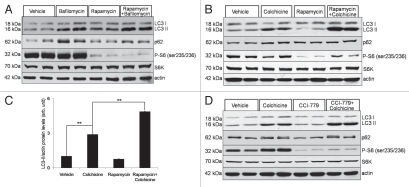Figure 3.
(A) Differentiated C2C12 myotubes were treated with vehicle, 200 nM BafilomycinA1, 10 µg/mL rapamycin or 10 µg/mL rapamycin plus 200 nM BafilomycinA1 for 6 hours. Lysates were subjected to LC3 and p62 immunoblots. Rapamycin did not increase LC3-II levels further than that seen with BafilomycinA1 alone. The same lysates were subjected to immunoblot with antibodies to phospho-S6 (Ser235/236) and S6 kinase demonstrating that rapamycin is capable of mTOR inhibition in these cells. Blot is representative of two independent experiments. (B) 3-month-old male mice were treated with vehicle, 0.4 mg/kg/day colchicine for two days, 10 mg/kg/day rapamycin for 7 days or 10 mg/kg/day rapamycin for 7 days and 0.4 mg/kg/day colchicine for two days beginning on day 5 and TA lysates were subjected to immunoblotting with LC3, p62, phospho-S6, total S6 kinase or actin. Blot is representative of four independent experiments. (C) LC3-II/actin ratios were quantitated via densitometry from eight mice per treatment condition. Error bars represent standard error and **denote p values of <0.005 as obtained by student paired t-test. (D) A similar experiment to (B) was performed using 20 mg/kg/day temsirolimus/CCI-779 instead of rapamycin. Note that the addition of temsirolimus/CCI-779 to colchicine further increased LC3-II levels consistent with an enhancement in autophagic flux.

